Medieval Dublin Coddle
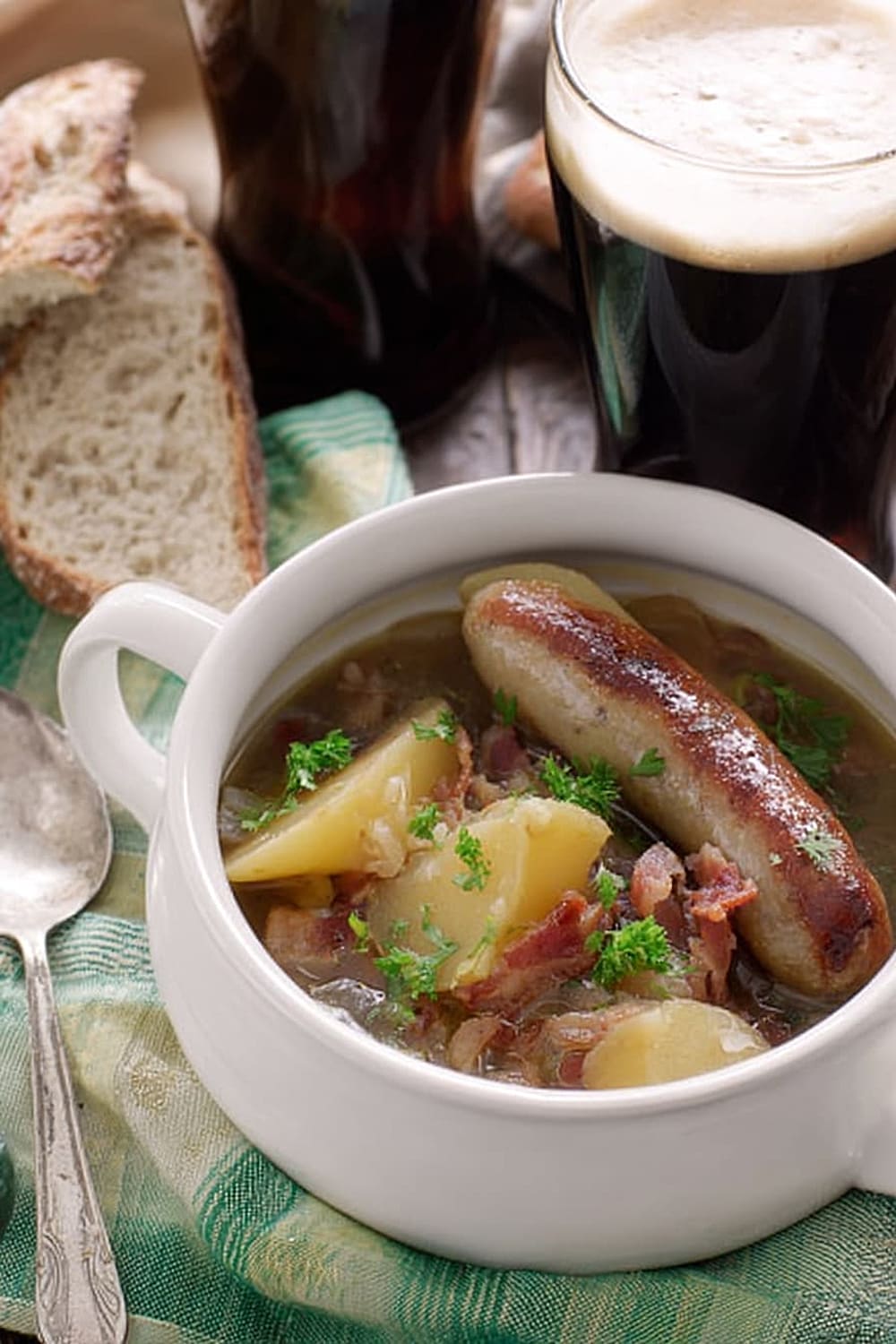
Get ready to fall head over heels for Ireland’s most comforting one-pot wonder that’ll have your kitchen smelling like pure heaven.
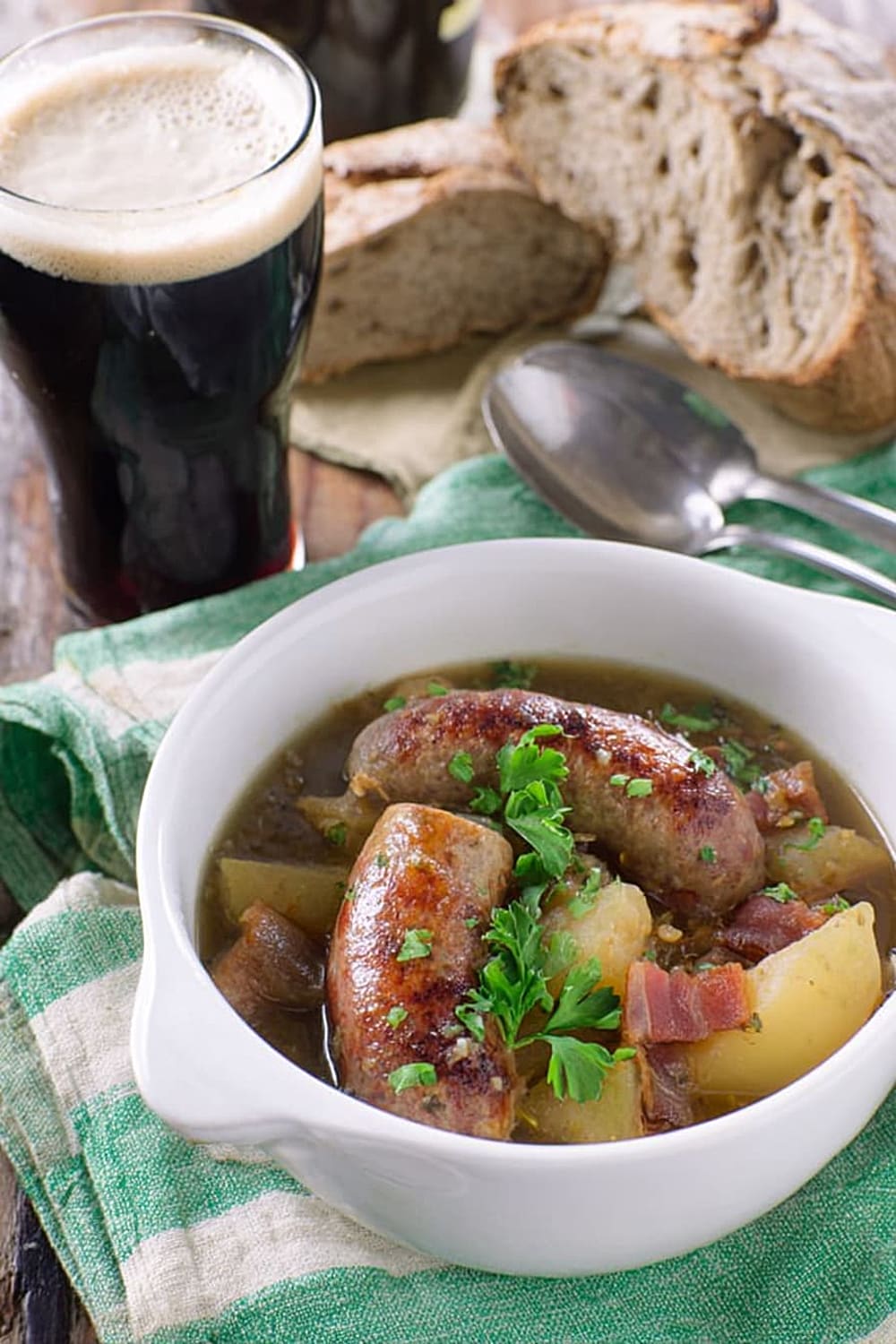
This rustic Dublin classic transforms simple ingredients into something absolutely magical, with layers of smoky bacon, savory sausages, and tender potatoes all mingling together in perfect harmony.
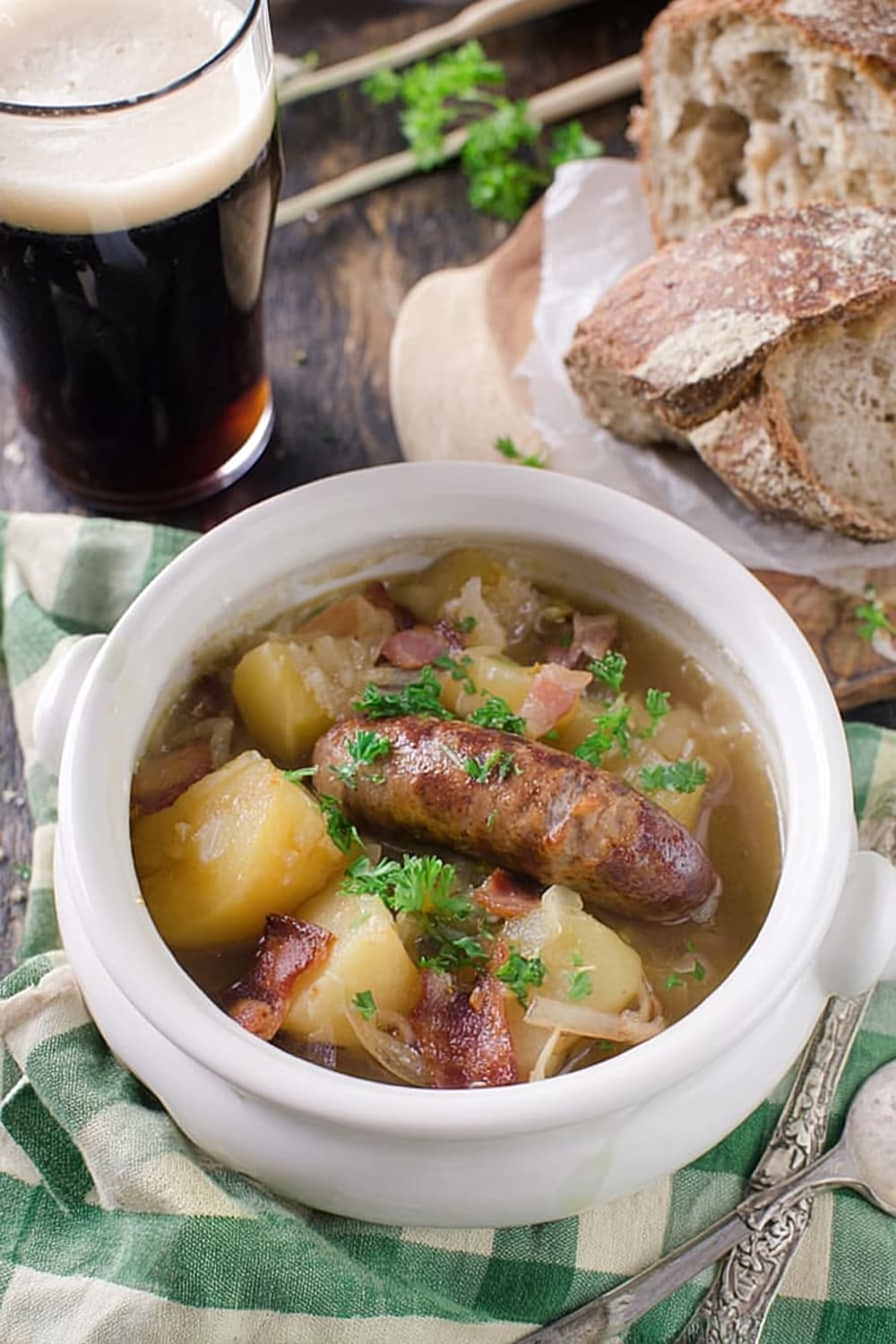
The beauty of this medieval recipe lies in its gorgeous simplicity – just layer everything in your trusty Dutch oven and let the oven work its slow-cooking magic for an hour and a half.

Every spoonful delivers that soul-warming combination of crispy-edged bacon, perfectly seasoned sausages, and melt-in-your-mouth potatoes that have absorbed all those incredible flavors.

What makes this coddle truly special is how the ingredients create their own rich, savory broth as they cook, filling your home with the most incredible aroma that’ll have everyone gathering in the kitchen.

Fair warning: once you master this authentic Irish comfort food, you’ll become the hero of every chilly evening and the person everyone calls when they need serious comfort food.
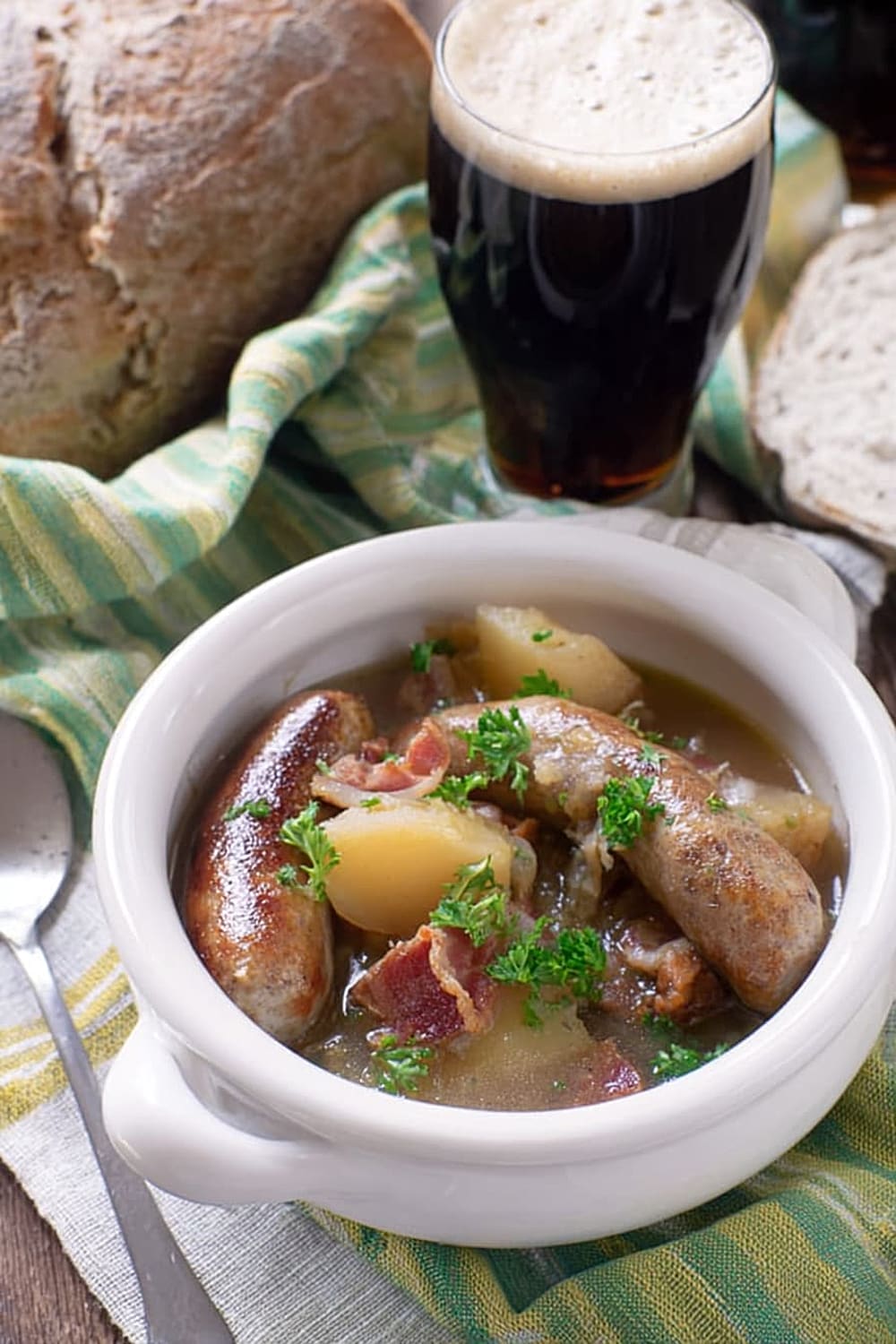
Ingredients
For the Protein Base
- 1 pound thick-cut bacon, cut into 2-inch pieces
- 1 pound flavorful pork sausages (garlicky Irish sausages work beautifully)
For the Vegetable Foundation
- 4 pounds Russet potatoes, peeled and cut into thick slices (1½-2 inches)
- 2 large onions, thickly sliced
- Small handful fresh parsley, chopped
For the Cooking Liquid
- 2 cups ham stock (or chicken or beef stock)
- Freshly ground black pepper to taste

Instructions
Preparation
- 1 Preheat your oven to 300°F (150°C) to ensure gentle, even cooking that allows all the flavors to meld perfectly.
Cook the Meats
- 2 Cook the bacon in a large 5-6 quart Dutch oven or casserole dish over medium heat until just cooked through, about 6-8 minutes. The bacon should be cooked but not crispy since it will continue cooking in the oven.
- 3 Lift the bacon out with tongs and set on a plate for now. Pour out most of the grease, leaving just a thin film for browning the sausages.
- 4 Add the sausages to the same pan and brown on all sides over medium-high heat, about 8-10 minutes total. You want a beautiful golden-brown color that will add depth to the final dish. Transfer sausages to the plate with the bacon.
- 5 If there’s more than a thin film of grease remaining in the pan, pour it out, but don’t clean the pan – those browned bits will add incredible flavor.
Layer and Assemble
- 6 Lay the sliced onions in an even layer on the bottom of the same Dutch oven. The onions will create a flavorful base and prevent sticking.
- 7 Scatter some of the chopped parsley over the onions and grind a generous amount of black pepper over everything – about 10-12 grinds from your pepper mill.
- 8 Add the bacon and sausages in an even layer over the onions, then repeat with more parsley and freshly ground black pepper.
- 9 Finish by layering the thick potato slices over the top, overlapping slightly if needed. Sprinkle with the remaining parsley and more black pepper – this will be your beautiful top layer.
- 10 Pour the 2 cups of stock evenly over everything, ensuring it reaches into all the corners and layers.
Slow Cook to Perfection
- 11 Set the Dutch oven over high heat and bring to a vigorous boil, about 3-4 minutes. You’ll hear the liquid bubbling actively.
- 12 Cover tightly with the lid and transfer to your preheated 300°F (150°C) oven. Cook for 90 minutes, checking liquid levels once around the 45-minute mark.
- 13 Add more stock or water if necessary to maintain about 1 inch of liquid at the bottom of the pot throughout cooking. The liquid should never completely evaporate.
Final Touches
- 14 After removing from the oven, let rest for 5 minutes, then check seasoning and adjust as needed. You likely won’t need salt since the bacon, sausages, and stock provide plenty of sodium.
- 15 Serve hot with crusty bread or traditional Irish soda bread to mop up every drop of those incredible juices.

Recommended Equipment and Kitchen Tools
Essential Tools (for best results):
- Dutch oven or heavy casserole dish (5-6 quarts) – A quality cast iron Dutch oven distributes heat evenly and goes seamlessly from stovetop to oven, creating the perfect cooking environment for this traditional recipe
- Sharp chef’s knife – Essential for cleanly slicing onions and cutting bacon into uniform pieces that cook evenly
- Sturdy tongs – Perfect for safely turning sausages and transferring hot meats without piercing them
- Instant-read thermometer – Helps ensure sausages reach the safe internal temperature of 160°F (71°C)
Helpful Upgrades:
- Mandoline slicer – Creates perfectly uniform potato slices that cook at the same rate, though a sharp knife works just fine
- Kitchen scale – Professional chefs swear by weighing ingredients for consistent results, especially helpful for portioning the bacon and sausages
- Silicone-tipped tongs – Won’t scratch your Dutch oven’s surface and provide excellent grip on slippery meats
Nice-to-Have Options:
- Parchment paper – Line your prep area for easy cleanup when cutting bacon
- Large cutting board – Gives you plenty of space to organize all your prepped ingredients before cooking begins
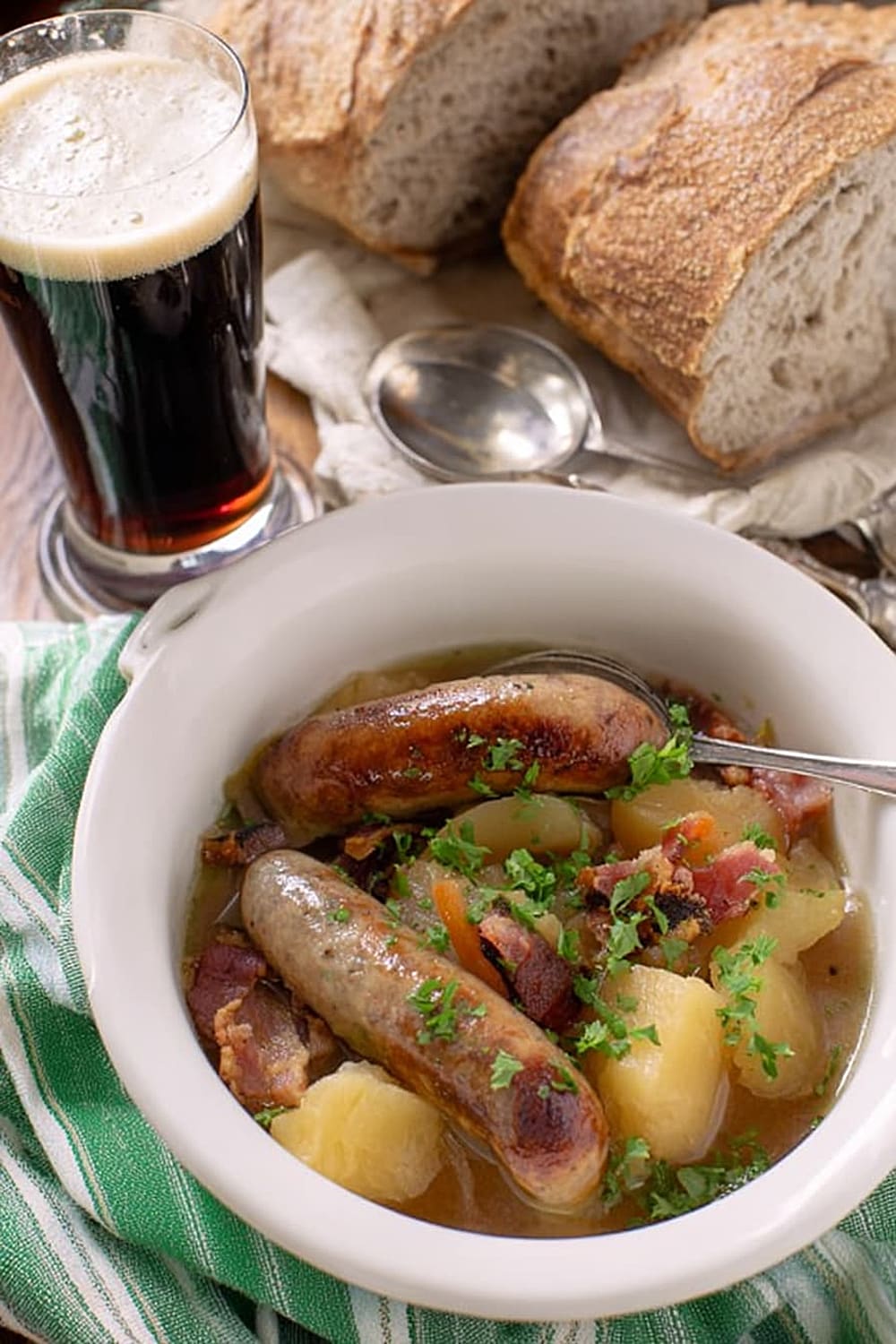
Recipe Variations and Dietary Modifications
Traditional Irish Variations:
- White Pudding Addition – Add 8 ounces sliced white pudding alongside the sausages for an even more authentic Dublin experience
- Guinness Enhancement – Replace 1 cup of stock with 1 cup Guinness stout for deeper, richer flavor
- Root Vegetable Medley – Add 2 large carrots and 2 parsnips, cut into thick rounds, layered with the potatoes
Healthier Modifications:
- Turkey Bacon Swap – Use 1 pound turkey bacon instead of pork bacon to reduce saturated fat content
- Chicken Sausage Option – Substitute with 1 pound chicken sausages for a leaner protein profile
- Sweet Potato Twist – Replace half the Russet potatoes with 2 pounds sweet potatoes for added vitamins and natural sweetness
Flavor Variations:
- Herb-Crusted Version – Add 2 tablespoons fresh thyme and 1 tablespoon fresh rosemary between the layers
- Spicy Dublin Coddle – Include 1 diced jalapeño with the onions and use spicy Irish sausages
- Smoky Paprika Style – Dust each layer with 1 teaspoon smoked paprika for deeper smokiness
Seasonal Adaptations:
- Spring Coddle – Add 1 pound baby potatoes and 1 bunch scallions for a lighter, fresher version
- Winter Root Vegetable – Include 2 cups diced turnips and 1 cup diced rutabaga for heartier cold-weather comfort
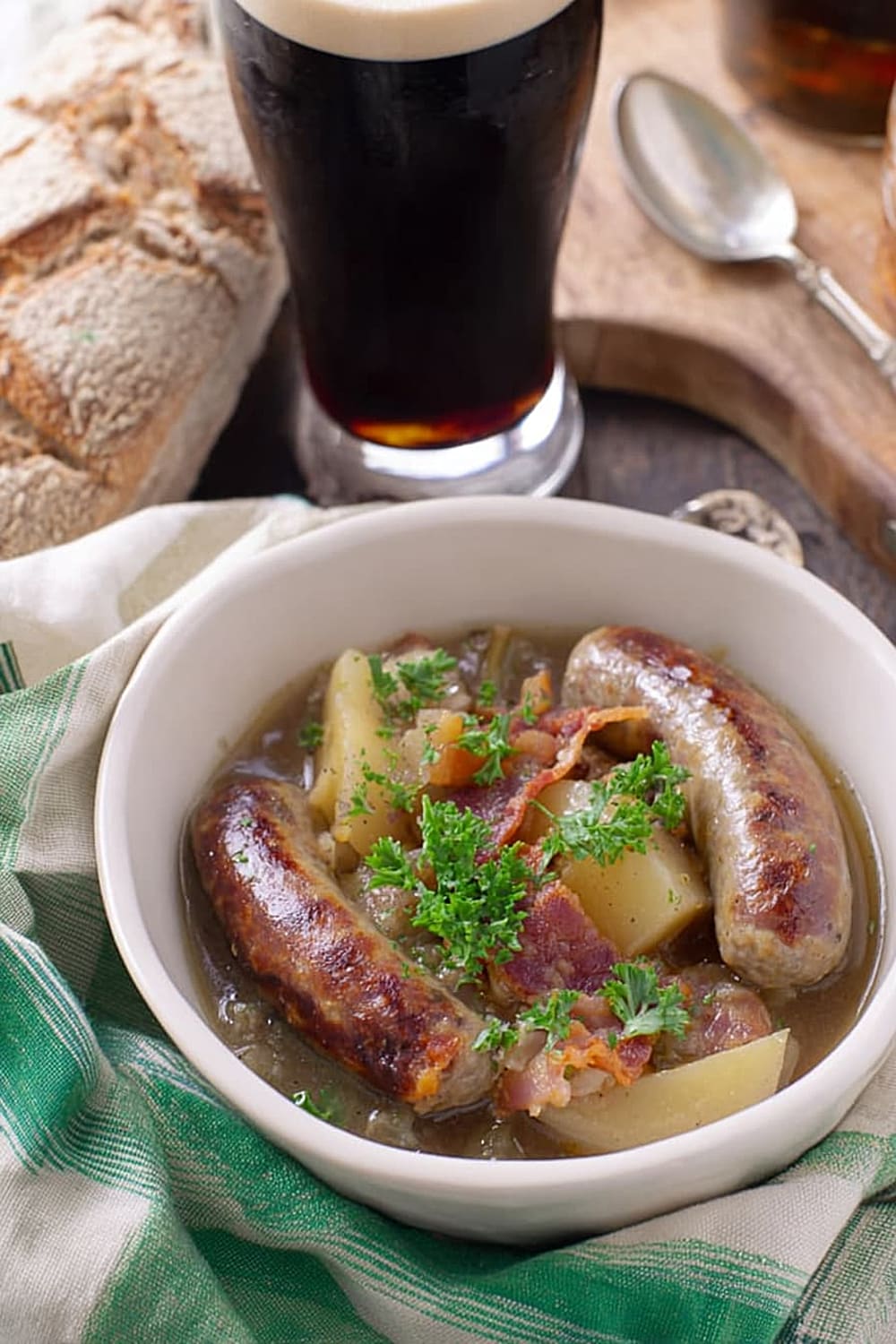
Nutritional Information and Health Benefits
Key Nutritional Highlights:
This hearty Dublin coddle provides approximately 485 calories per serving when divided among 6-8 people. The dish offers a substantial 28 grams of protein from the bacon and sausages, making it incredibly satisfying and perfect for active individuals. The 4 pounds of potatoes contribute complex carbohydrates and about 6 grams of fiber per serving, supporting sustained energy and digestive health.
Health Benefits of Main Ingredients:
The Russet potatoes are nutritional powerhouses, providing significant amounts of potassium (more than bananas!), vitamin C, and vitamin B6, which support heart health and immune function. Fresh parsley adds more than just color – it’s packed with vitamin K for bone health and contains powerful antioxidants that may help reduce inflammation. The onions provide quercetin, a flavonoid with anti-inflammatory properties, plus prebiotic fiber that supports gut health. Even the pork proteins contribute essential amino acids, iron, and B-vitamins necessary for energy metabolism.
Dietary Considerations:
This recipe is naturally gluten-free (check sausage labels to confirm), making it suitable for those with celiac disease or gluten sensitivity. It’s also dairy-free as written. The high sodium content from bacon and sausages means those watching sodium intake should enjoy smaller portions or choose lower-sodium alternatives. Each serving provides about 35% of daily protein needs, making it an excellent choice for those following higher-protein eating patterns.

Smart Swaps and Ingredient Substitutions
Common Substitutions:
- Thick-cut bacon → Canadian bacon or pancetta (use same amount, adds different flavor profile)
- Pork sausages → Bratwurst or Italian sausages (choose based on preferred spice level)
- Ham stock → Chicken stock, beef stock, or vegetable stock (maintains liquid ratios)
- Russet potatoes → Yukon Gold potatoes (creamier texture, slightly different cooking time)
Budget-Friendly Swaps:
- Thick-cut bacon → Regular bacon cut into larger pieces (more affordable, similar results)
- Garlicky Irish sausages → Polish kielbasa or smoked sausage (widely available, budget-friendly)
- Fresh parsley → Dried parsley using 1 tablespoon instead of fresh handful
Pantry Emergency Substitutions:
- Ham stock → 2 cups water plus 2 bouillon cubes or 2 teaspoons Better Than Bouillon
- Fresh onions → 2 cups frozen pearl onions, thawed (convenient option)
- Fresh parsley → 1 tablespoon dried chives or 2 teaspoons dried thyme
Pro Tips for Substitutions:
- Store extra stock in ice cube trays for easy portioning in future recipes
- When using leaner meats, add 1 tablespoon olive oil to prevent sticking and maintain moisture
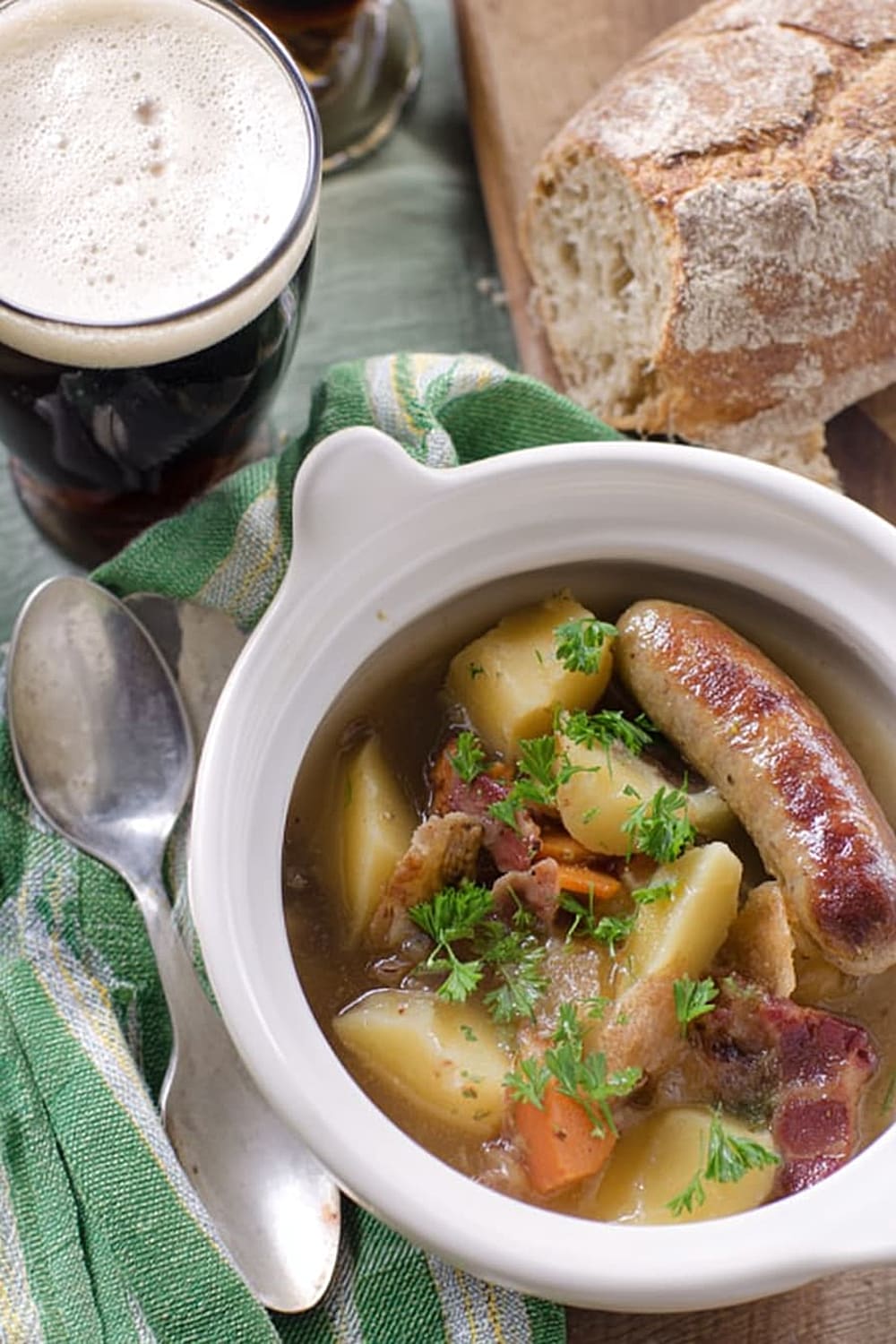
Make It Diabetes-Friendly
Carb Reduction Strategies:
- Replace 2 pounds potatoes with 2 pounds cauliflower florets to reduce carbs by approximately 120 grams per recipe
- Use turnips or radishes as potato substitutes – they absorb flavors beautifully while providing only 6 grams carbs per cup versus 26 grams for potatoes
- Try a 50/50 mix of potatoes and cauliflower for gradual carb reduction while maintaining familiar texture
Protein Enhancement:
- Add extra sausages (increase to 1.5 pounds) to boost protein content and increase satiety
- Include 1 cup white beans for added fiber and plant-based protein while keeping carbs moderate
- Choose high-protein, low-carb sausages with less than 2 grams carbs per serving
Portion & Timing Tips:
- Serve 1-cup portions with a large side salad to increase volume while controlling carbs
- Pair with 2 ounces cheese or 1/4 cup nuts to add healthy fats that slow glucose absorption
- Estimated carbs per serving: Traditional version has about 45 grams, cauliflower version has approximately 15 grams
Total Carb Reduction: Cauliflower substitution reduces total recipe carbs from 360 grams to 120 grams
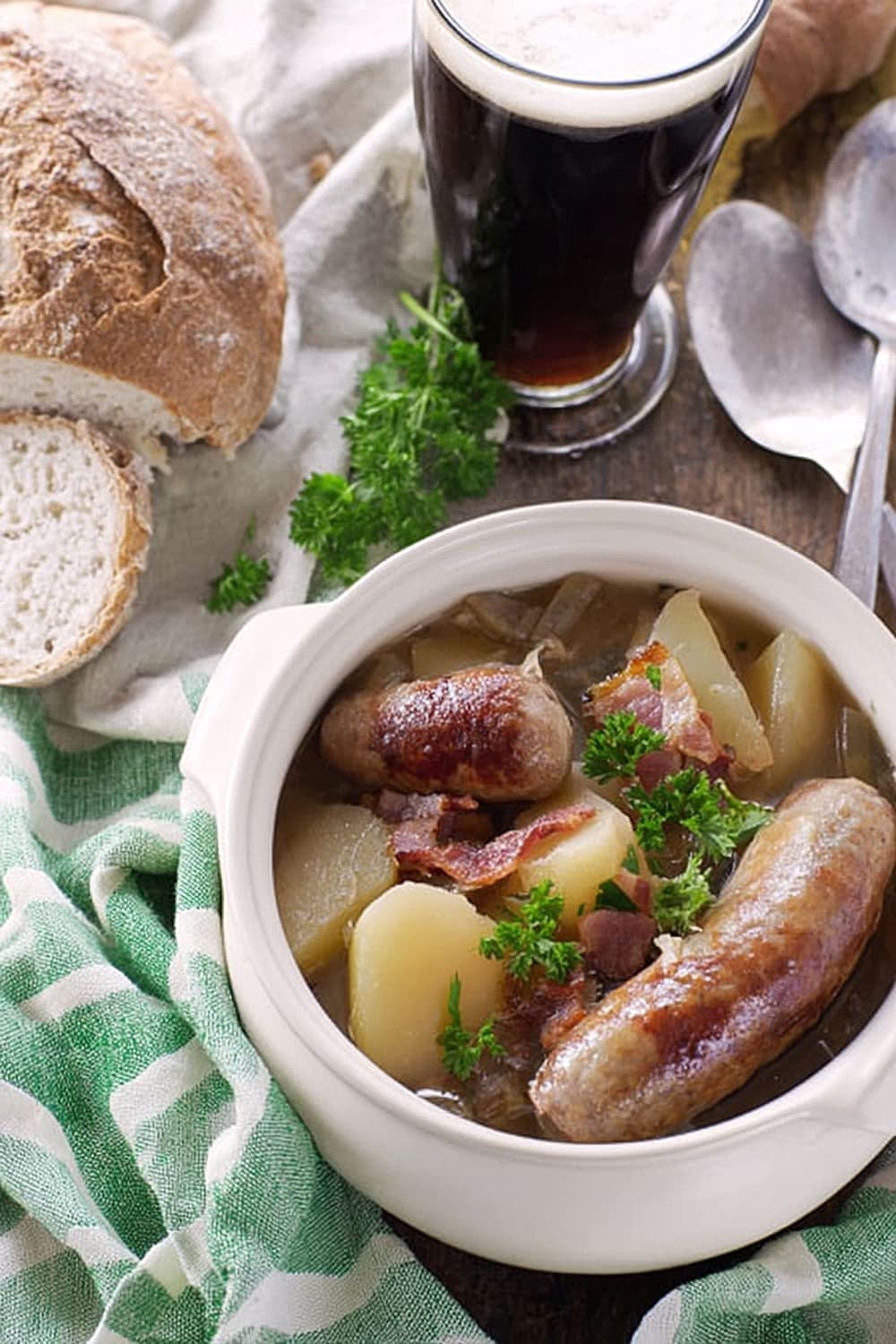
Perfect Pairing Suggestions
Beverage Pairings:
A robust Irish stout like Guinness complements the rich, savory flavors perfectly, while the beer’s slight bitterness balances the bacon’s smokiness. For wine lovers, try a medium-bodied red wine such as Côtes du Rhône or Irish red ale. Non-alcoholic options include sparkling apple cider, which echoes traditional Irish flavors, or robust black tea with milk for an authentic Dublin experience.
Side Dish Recommendations:
Traditional Irish soda bread is the classic accompaniment – its dense, slightly tangy crumb soaks up the savory juices beautifully. Colcannon (mashed potatoes with cabbage) adds more Irish authenticity, while braised red cabbage provides a colorful, slightly sweet contrast to the rich meats. Simple steamed green beans or roasted Brussels sprouts add fresh vegetable balance and vibrant color to the plate.
Complete Meal Ideas:
Start with Irish potato and leek soup as a lighter appetizer, then serve the coddle as your hearty main course. Follow with traditional Irish coffee and shortbread cookies for a completely themed meal. For entertaining, add Irish cheese and oatcakes as appetizers and finish with bread pudding with whiskey sauce.
Occasion Suggestions:
This coddle shines at St. Patrick’s Day celebrations, casual family dinners, and cold weather gatherings. It’s perfect for meal prep Sundays since it reheats beautifully, and ideal for potluck dinners where you need to feed a crowd affordably. The rustic presentation makes it perfect for casual entertaining rather than formal dinner parties.

Pro Tips and Troubleshooting
Professional Cooking Tips:
Layer ingredients in the exact order specified – onions on bottom prevent sticking, while potatoes on top create a beautiful presentation when served. Don’t skip the browning step for sausages; those caramelized bits add incredible depth to the final dish. Use thick potato slices (1½-2 inches) because thinner slices will break down too much during the long cooking time. Check liquid levels at the 45-minute mark to ensure proper steam and prevent burning.
Common Mistakes and Solutions:
Overcrowding the pan when browning sausages leads to steaming instead of browning – work in batches if necessary. Using too high oven temperature causes the top to dry out while the bottom stays soggy; 300°F (150°C) is perfect for gentle, even cooking. Adding salt too early can make the dish overly salty since bacon and sausages release salt as they cook.
Storage and Make-Ahead Tips:
Refrigerate leftovers for up to 4 days in airtight containers. Reheat gently in a 300°F (150°C) oven for 20-25 minutes until heated through. Freeze portions for up to 3 months – thaw overnight in refrigerator before reheating. Assemble the night before and refrigerate, then add 15 minutes to cooking time when baking from cold.
Scaling and Presentation:
Double the recipe easily in a larger roasting pan for crowds. Individual portions can be assembled in 6-8 ramekins for elegant presentation, reducing cooking time to 60 minutes. Garnish with extra fresh parsley and serve directly from the Dutch oven for rustic charm.
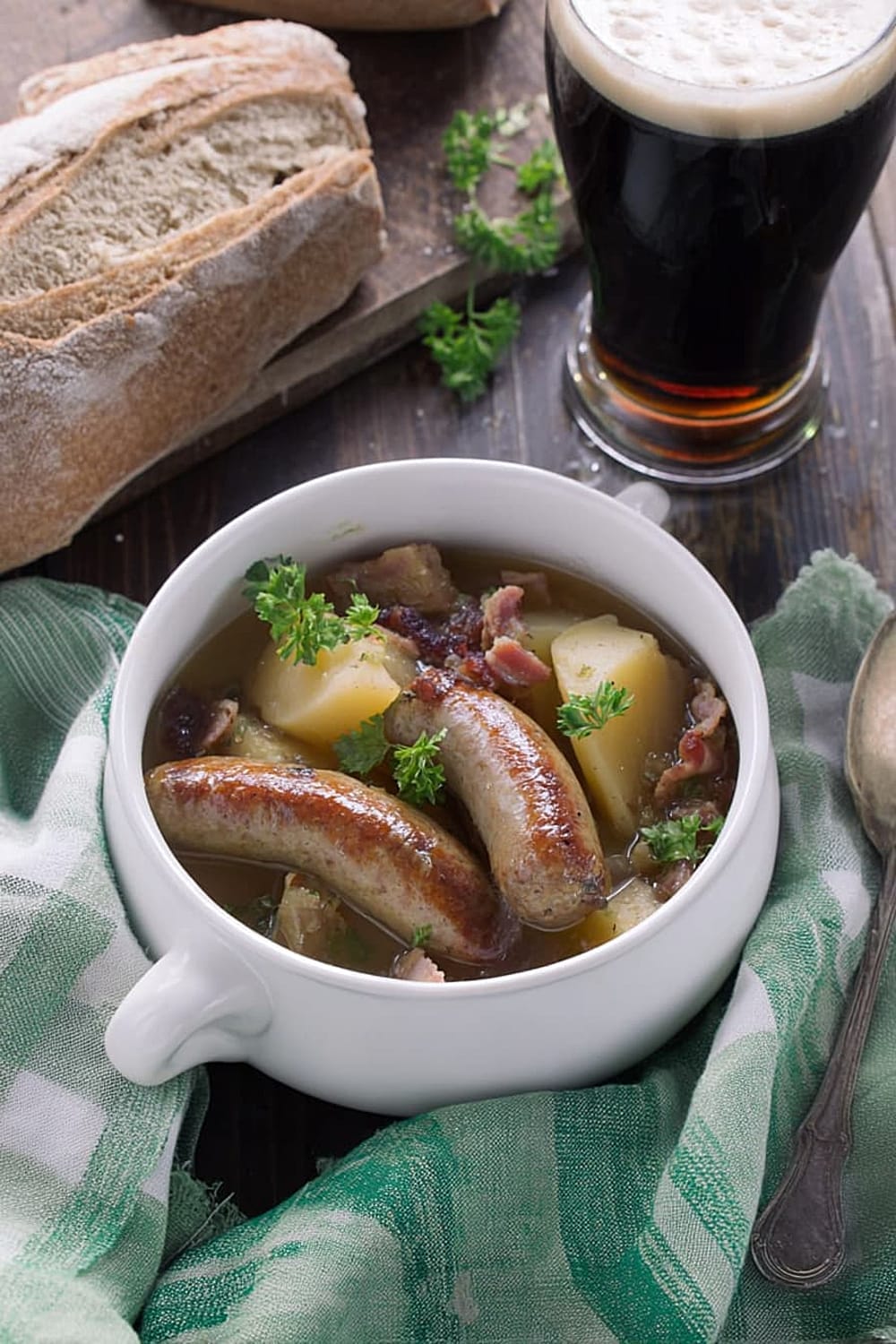
There you have it – authentic Medieval Dublin Coddle that’ll transport your taste buds straight to the cobblestone streets of Ireland while filling your home with the most incredible aromas. This one-pot wonder proves that the best comfort food often comes from the simplest ingredients, transformed through time-honored techniques into something absolutely magical that’ll have everyone asking for seconds.